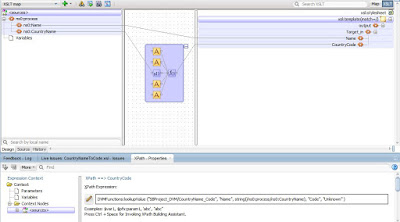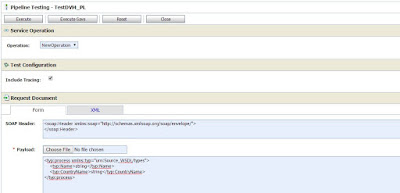Recently I was trying to open Oracle Service bus console, it was not opening. Then I logged into Weblogic console, where inside server tab, all Managed Servers and Admin server was in Warning state.
With curiosity I wanted to know, what is wrong with the servers. so I opened the weblogic server logs. In the logs the below content was repeatedly written
Feb 19, 2016 2:21:00 AM oracle.security.jps.internal.idstore.util.LibOvdUtil pushLdapNamesToLibOvd
INFO: Pushed ldap name and types info to libOvd. Ldaps : DefaultAuthenticator:idstore.ldap.provideridstore.ldap.
[EL Severe]: ejb: 2016-02-19 02:21:00.467--ServerSession(1545095313)--Exception [EclipseLink-4002] (Eclipse Persistence Services - 2.5.2.v20140319-9ad6abd): org.eclipse.persistence.exceptions.DatabaseException
Internal Exception: java.sql.SQLException: ORA-00257: archiver error. Connect internal only, until freed.
Error Code: 257
[EL Severe]: ejb: 2016-02-19 02:21:00.546--ServerSession(1545095313)--Exception [EclipseLink-4002] (Eclipse Persistence Services - 2.5.2.v20140319-9ad6abd): org.eclipse.persistence.exceptions.DatabaseException
Internal Exception: java.sql.SQLException: ORA-00257: archiver error. Connect internal only, until freed.
Error Code: 257
[EL Severe]: ejb: 2016-02-19 02:21:00.62--ServerSession(1545095313)--Exception [EclipseLink-4002] (Eclipse Persistence Services - 2.5.2.v20140319-9ad6abd): org.eclipse.persistence.exceptions.DatabaseException
Internal Exception: java.sql.SQLException: ORA-00257: archiver error. Connect internal only, until freed.
Error Code: 257
Feb 19, 2016 2:21:00 AM oracle.security.jps.internal.config.OpssCommonStartup start
INFO: Jps startup failed.
<Feb 19, 2016 2:21:00 AM MST> <Error> <Security> <BEA-090892> <The loading of an OPSS java security policy provider failed due to an exception. See the exception stack trace or the server log file for the root cause. If there is no obvious cause, enable the debug flag -Djava.security.debug=jpspolicy to get more information. Error message: null>
<Feb 19, 2016 2:21:00 AM MST> <Critical> <WebLogicServer> <BEA-000386> <Server subsystem failed. Reason: A MultiException has 6 exceptions. They are:
1. weblogic.security.SecurityInitializationException: The loading of an OPSS java security policy provider failed due to an exception. See the exception stack trace or the server log file for the root cause. If there is no obvious cause, enable the debug flag -Djava.security.debug=jpspolicy to get more information. Error message: null
2. java.lang.IllegalStateException: Unable to perform operation: post construct on weblogic.security.PreSecurityService
3. java.lang.IllegalArgumentException: While attempting to resolve the dependencies of weblogic.security.SecurityService errors were found
4. java.lang.IllegalStateException: Unable to perform operation: resolve on weblogic.security.SecurityService
5. java.lang.IllegalArgumentException: While attempting to resolve the dependencies of weblogic.nodemanager.adminserver.NodeManagerMonitorService errors were found
6. java.lang.IllegalStateException: Unable to perform operation: resolve on weblogic.nodemanager.adminserver.NodeManagerMonitorService
A MultiException has 6 exceptions. They are:
1. weblogic.security.SecurityInitializationException: The loading of an OPSS java security policy provider failed due to an exception. See the exception stack trace or the server log file for the root cause. If there is no obvious cause, enable the debug flag -Djava.security.debug=jpspolicy to get more information. Error message: null
2. java.lang.IllegalStateException: Unable to perform operation: post construct on weblogic.security.PreSecurityService
3. java.lang.IllegalArgumentException: While attempting to resolve the dependencies of weblogic.security.SecurityService errors were found
4. java.lang.IllegalStateException: Unable to perform operation: resolve on weblogic.security.SecurityService
5. java.lang.IllegalArgumentException: While attempting to resolve the dependencies of weblogic.nodemanager.adminserver.NodeManagerMonitorService errors were found
6. java.lang.IllegalStateException: Unable to perform operation: resolve on weblogic.nodemanager.adminserver.NodeManagerMonitorService
at org.jvnet.hk2.internal.Collector.throwIfErrors(Collector.java:88)
at org.jvnet.hk2.internal.ClazzCreator.resolveAllDependencies(ClazzCreator.java:269)
at org.jvnet.hk2.internal.ClazzCreator.create(ClazzCreator.java:413)
[EL Severe]: ejb: 2016-02-19 02:20:59.486--ServerSession(1545095313)--Exception [EclipseLink-4002] (Eclipse Persistence Services - 2.5.2.v20140319-9ad6abd): org.eclipse.persistence.exceptions.DatabaseException
Internal Exception: java.sql.SQLException: ORA-00257: archiver error. Connect internal only, until freed.
Error Code: 257
Feb 19, 2016 2:20:59 AM oracle.security.jps.internal.common.config.AbstractSecurityStore getSecurityStoreVersion
WARNING: Unable to get the Version from Store returning the default
oracle.security.jps.service.policystore.PolicyStoreException: javax.persistence.PersistenceException: Exception [EclipseLink-4002] (Eclipse Persistence Services - 2.5.2.v20140319-9ad6abd): org.eclipse.persistence.exceptions.DatabaseException
Internal Exception: java.sql.SQLException: ORA-00257: archiver error. Connect internal only, until freed.
Error Code: 257
at oracle.security.jps.internal.policystore.rdbms.JpsDBDataManager.processJPAException(JpsDBDataManager.java:2180)
at oracle.security.jps.internal.policystore.rdbms.JpsDBDataManager.init(JpsDBDataManager.java:1028)
at oracle.security.jps.internal.policystore.rdbms.JpsDBDataManager.jpsObjectBaseQuery(JpsDBDataManager.java:3089)
at oracle.security.jps.internal.policystore.rdbms.JpsDBDataManager.queryBaseObjects(JpsDBDataManager.java:5761)
at oracle.security.jps.internal.common.config.AbstractSecurityStore.getSecurityStoreVersion(AbstractSecurityStore.java:211)
at oracle.security.jps.internal.common.config.AbstractSecurityStore.getSecurityStoreVersion(AbstractSecurityStore.java:195)
at oracle.security.jps.internal.common.config.AbstractSecurityStore.<init>(AbstractSecurityStore.java:99)
at oracle.security.jps.internal.keystore.FarmKeyStoreServiceImpl.<init>(FarmKeyStoreServiceImpl.java:121)
at oracle.security.jps.internal.keystore.ldap.LdapKeyStoreServiceImpl.<init>(LdapKeyStoreServiceImpl.java:106)
at oracle.security.jps.internal.keystore.KeyStoreProvider.createInstance(KeyStoreProvider.java:356)
at oracle.security.jps.internal.keystore.KeyStoreProvider.createInstance(KeyStoreProvider.java:329)
at oracle.security.jps.internal.keystore.KeyStoreProvider.getInstance(KeyStoreProvider.java:271)
at oracle.security.opss.internal.runtime.ServiceContextManagerImpl.createContextInternal(ServiceContextManagerImpl.java:432)
at oracle.security.opss.internal.runtime.ServiceContextManagerImpl.createDefaultContext(ServiceContextManagerImpl.java:216)
at oracle.security.opss.internal.runtime.ServiceContextManagerImpl.initialize(ServiceContextManagerImpl.java:156)
at oracle.security.opss.internal.runtime.ServiceContextManagerImpl.initialize(ServiceContextManagerImpl.java:112)
at oracle.security.jps.internal.config.OpssCommonStartup$1.run(OpssCommonStartup.java:158)
at java.security.AccessController.doPrivileged(Native Method)
at oracle.security.jps.internal.config.OpssCommonStartup.start(OpssCommonStartup.java:110)
at oracle.security.jps.wls.JpsWlsStartup.start(JpsWlsStartup.java:80)
This error is related with the Database available space issue. Check with Database team, if your Database is handled by different team, If you handle database by yourself, then look for the available space in Database.
Once you have, increased the space in the Database for the schemas which are being used by Weblogic servers, then you can restart weblogic server instances.




























